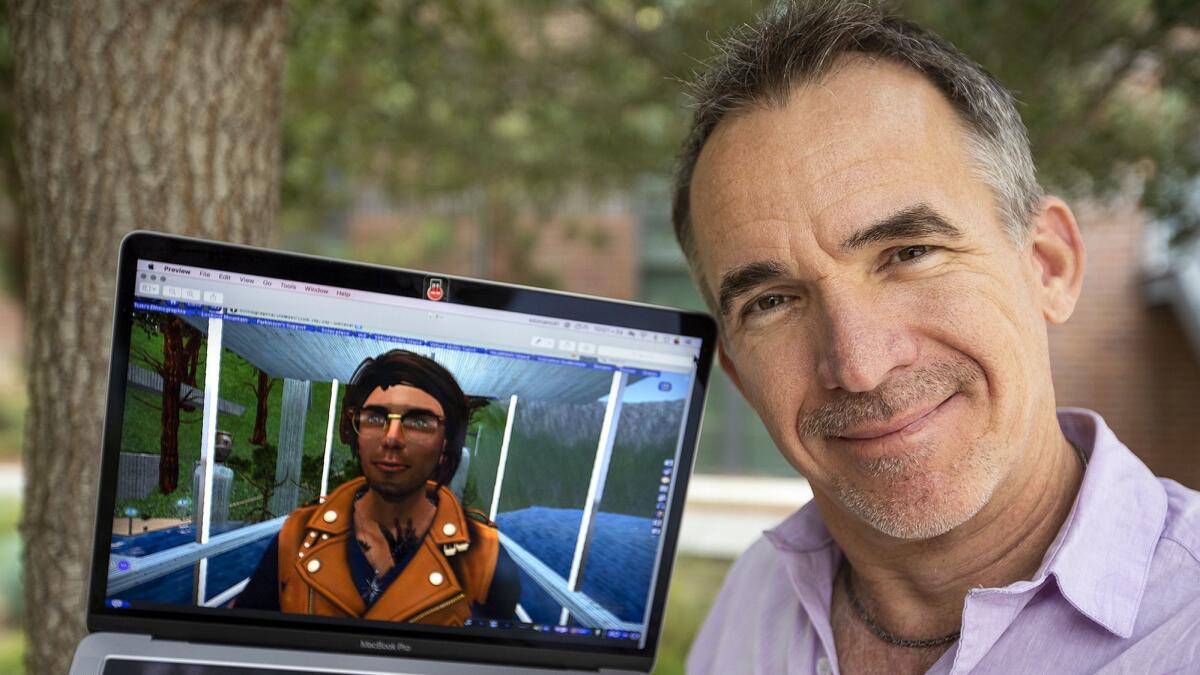Virtual world provides a real-life haven for the disabled

- Share via
Cody LaScala nearly drowned on his first birthday.
His mother found him lifeless at the bottom of a swimming pool, unresponsive to CPR.
LaScala was comatose for months. He finally regained consciousness, but with cerebral palsy, which impedes his speech and movement and requires him to use a wheelchair.
Communicating isn’t easy, but he’s found a way to connect through Second Life.
UC Irvine anthropology professor Tom Boellstorff studied LaScala and hundreds of other disabled players in his research into how they use Second Life for social interaction that often escapes them in nonvirtual settings.
Boellstorff started playing in 2004 under the avatar Tom Bukowski. He’d become interested in studying new virtual worlds with the same methods he used in the field as an anthropologist observing gay and lesbian culture in Indonesia.
Boellstorff found that physical world research techniques transferred to the virtual one, including participant-observation, a method used by cultural anthropologists.
“The approach is like the old saying, ‘When in Rome, do as the Romans do,’ ” Boellstorff explained.
Just like the physical world, Second Life features malls, offices, clubs and homes. So Boellstorff’s avatar spent much of his time participating in the same routines as Second Life players, observing their virtual everday activities.
Boellstorff’s research in the first few years focused on general game culture rather than specifically on disabled players.
In 2008 he published a book, “Coming of Age in Second Life,” and then turned his focus to the disabled, who make up 40% to 60% of the game’s population.
“Questions about disability are questions about the human experience,” Boellstorff said. “It is not a niche topic. Everyone will become disabled eventually in their life if they live long enough.”
Boellstorff and co-researcher Donna Davis of the University of Oregon got to know about 200 disabled players.
The researchers found the virtual world provides a way for the mentally and physically disabled to socialize and forge meaningful relationships.
“We so often hear about the dark side of technology,” Davis said. “But I think that Tom and I have found that there is a bright side. People can connect in these virtual spaces in really important and meaningful ways.”
Sebastian Bouevier, one of the subjects, suffers from bipolar, post-traumatic stress and general anxiety disorders.
“Second Life has been a kind of lifeline for me, allowing to socialize and interact with other people from the comfort and safety of my own home,” Bouevier said over email. “When I feel a panic attack coming on, I can teleport to my own little hideaway and listen to calming music, or log out if I want to unplug completely. It isn’t that easy in real life.
“If I get a panic attack in a mall, there isn’t really anywhere nearby where I can hide out until it passes. Being in Second Life has also allowed me to meet many wonderful people with similar conditions to my own, and I have been able to learn a lot of coping skills from them.”
Disability prevents Di Zuidde, another subject, from having children. But her avatar, Lady, has several.
“Lady is someone for whom Second Life has been a very valuable way to create kinds of family,” Boellstorff said.
“Our Digital Selves: My Avatar is me!” a documentary about Davis’ and Boellstorrf’s research, featured Zuidde and was shown at a congressional meeting in May.
Also this year, Boellstorff and some of the disabled research subjects met with Second Life creator Philip Rosedale and Ebbe Altberg, chief executive of Linden Lab — which runs Second Life — to discuss their experiences with the technology.
Boellstorff’ has received $277,000 in funding from the National Science Foundation since 2015 to research how online environments affect social interaction, self-awareness and the disabled experience.
Boellstorff, who is writing a second book on his new research, hopes that his research will cause technology developers to pay heed to the issues of disabled people when creating virtual reality products.
“This is an important thing for these CEOs to look at,” Boellstorff said. “Over and over again, if you look at the history of technology, often the tech gets developed assuming the consumer is able-bodied.
“Then a couple of years later they realize they forgot about the disabled folks, and they develop some kind of add-on, which usually doesn’t work. We are in danger of that being the case with virtual reality.”
Twitter:@benbrazilpilot
All the latest on Orange County from Orange County.
Get our free TimesOC newsletter.
You may occasionally receive promotional content from the Daily Pilot.




